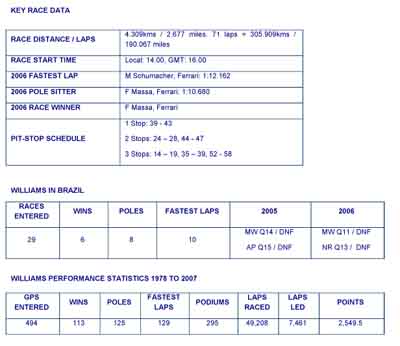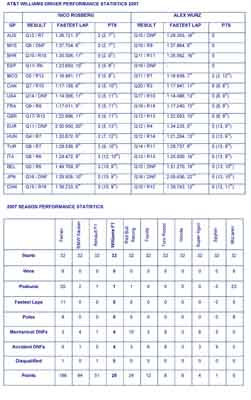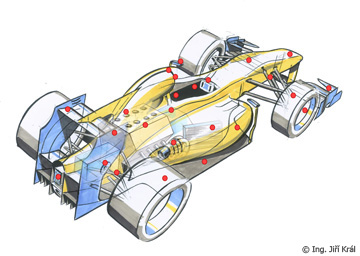TiskovÃĄ informace - WilliamsF1 (EN)
Miroslav SanytrÃĄk | 19.10.07 | Aktuality
15th OCTOBER 2007
BRAZILIAN GRAND PRIX PREVIEW
Brazil takes centre stage this weekend for the much anticipated 2007 FIA World Championship showdown. As three drivers fight for the Driversâ crown, this weekendâs race promises to be the most compelling of the season. Sao Pauloâs Interlagos track is the venue, with the Carlos Pace Autodromo celebrating its 25th anniversary in Formula One, having welcomed the sport for the first time in 1973. With the battle for the other Championship positions still on-going, AT&T Williams will be drawing on a wealth of experience attained in Brazil. The team has won one in five of all Brazilian Grand Prix entered, set 34% of all fastest laps and secured one in three pole positions.
Nico Rosberg
Interlagos is a great circuit and I am looking forward to it. Itâs a cool track, with a variety
of corners and surface undulations. The past two races have been difficult, so I hope to
finish the season well and to hold on to my present position in the Driversâ
Championship. Sao Paulo is also a place where you can have some fun in the evenings,
so I would imagine itâs going to be a good weekend. I am going to Rio de Janeiro first for
a PR day with Petrobras, so Iâll get to Sao Paulo early on in the week. Itâs fantastic for
Formula One to have a three-way battle for the Championship going into the last race of
the season, which is not a situation that happens very often. Personally, I hope Lewis
manages to win because he deserves it.
Kazuki Nakajima
Iâm obviously feeling really excited about my first Formula One race. Iâve never driven at
Interlagos before, so Iâve been doing lots of preparation work in the teamâs simulator at
Grove. Iâve also ramped up my training in the gym to help me cope with the pressures
on my neck because itâs an anti-clockwise track. It looks like itâs going to rain over the
weekend, so the weather is going to make the whole process quite tricky. Iâm trying not
to put any pressure on myself though. Iâm going to take it at my own pace, work through
each session step by and step and, above all, just enjoy it.
Sam Michael, Technical Director, Williams F1
Interlagos is a well laid out track. It has a lot of gradient changes over the lap and two
long straights which are crucial for overtaking. The performance of the car in the corners
that precede the straights is the most important consideration when it comes to car setup.
Lying 750 metres above sea level, Sao Paulo has the lowest ambient pressures of
any circuit that we race at. With pressures around 930mbar, we lose around 8% of our
normal downforce. Drag is also reduced by around 8%, but so is engine power, so top
speeds remain the same.
The grid line up is traditionally tight due to the low fuel penalty and short lap time. Coupled with a long pit lane, the strategy is a close call between a one and a two stop strategy so we will see a mix of both on race day. Bridgestone are bringing the Soft and Super Soft tyres to the race, but we may not get to use them as the forecast is currently predicting rain all weekend.
As this is the last race of the 2007 season, we will be pushing hard to claim points in the Constructorsâ Championship. We have had two races in a row where we havenât scored points due to various circumstances, but we are aiming to change that in Brazil.
Alex Wurz has retired and we thank him again for all his hard work in developing the FW29 and contributing to the Constructorsâ points for AT&T Williams this year. He is a great guy to work with and we wish him well for the future. As a result of Alexâs retirement, Kazuki will be in the car in Brazil making his Formula One debut. Itâs a big weekend for him as part of his next stage of development.
Interlagos Circuit, Sao Paulo, Brazil
The 71 lap Brazilian Grand Prix will be a true test of durability, heightened by the
fact that the race is run in an anti-clockwise direction. The 4.3km circuit consists
of 13 medium and slow speed corners, nine left and four right, and has a blend of
long, fast straights and gradient changes. With such a varied layout, set-up
compromises are inevitable, and the challenge lies in achieving optimal
aerodynamic efficiency around the lap. Interlagos is a notoriously bumpy circuit,
so not only is it draining on the drivers, but the cars must have a good
mechanical balance for driveability. Combined with the bumps, the track is also
particularly abrasive, so harder compound tyres must be selected to ensure their
survival. Engines are also under intense pressure in Brazil, with the long
straights demanding extensive periods at full throttle and high revs, while the
high altitude and thinning air saps approximately 8% of overall power around the
lap. Plenty of overtaking opportunities, combined with the areaâs unpredictable
weather conditions, will only enhance what is always an entertaining spectacle in
Brazil.
|
|






